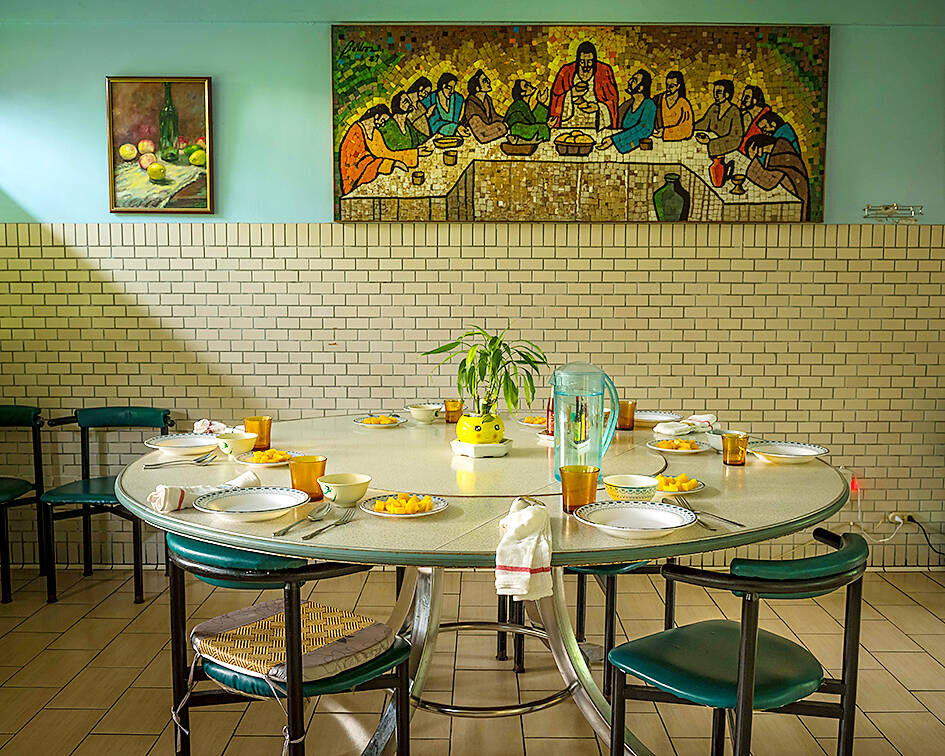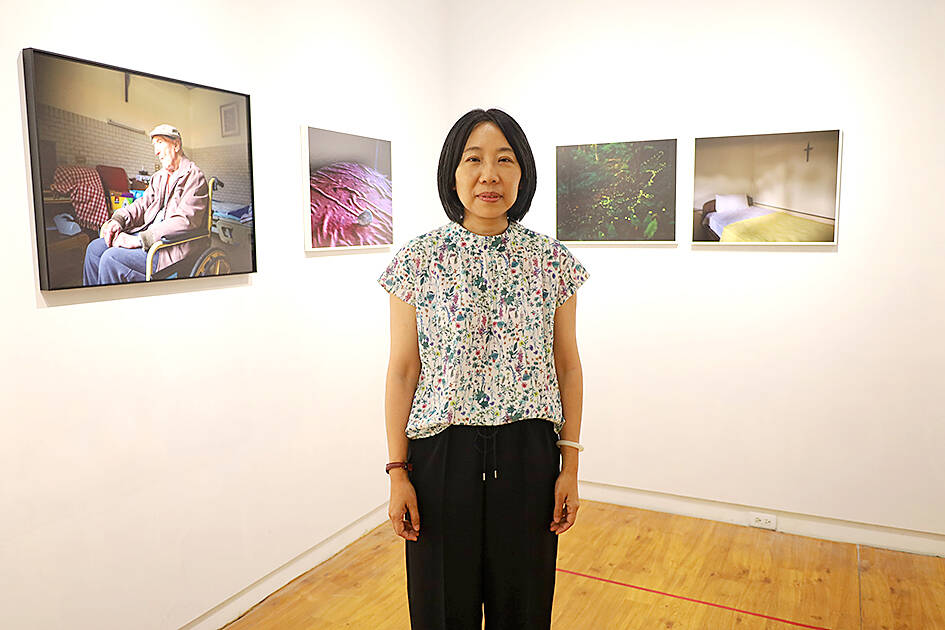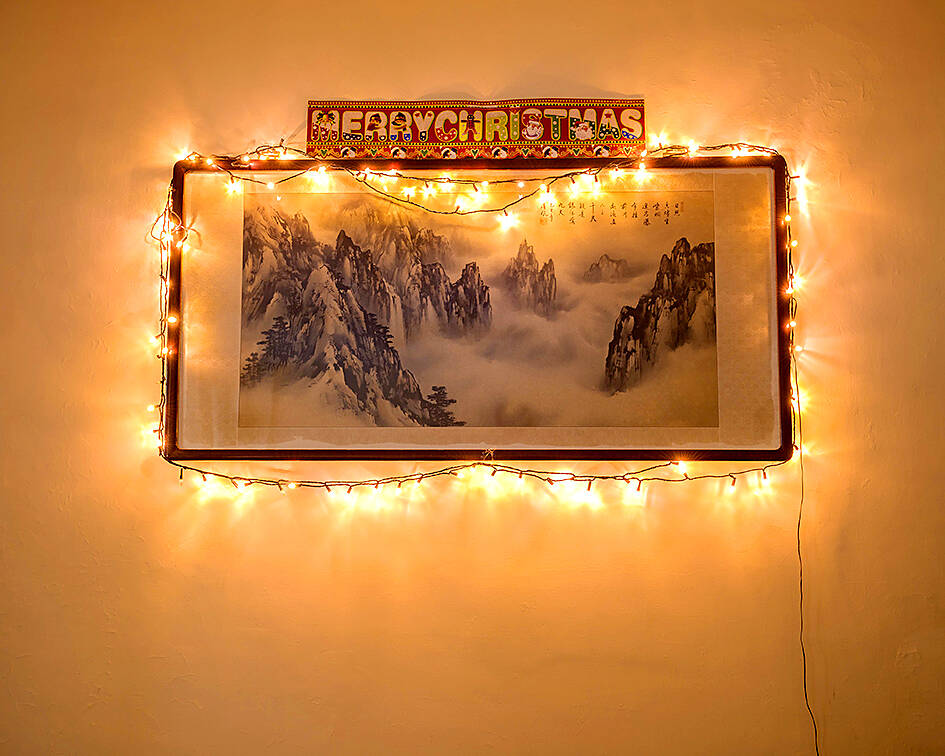In 2017, Chuang Ying-chih (莊?智) emerged onto the Taipei art scene with A Topographical Tale of Ximending, a photo series that documented marginalized communities living in Taipei’s Wanhua District (萬華).
The artworks won a number of awards including the Special Jury Award at the 2017 Young Art Taipei Contemporary Art Fair.
This month, she’s back with an equally stirring photo series A Time to Scatter Stones, which is currently on view at 1839 Contemporary Art Gallery (1839當代).
Photo courtesy of Chuang Ying-chih
As with her previous work, Chuang continues to study unique worlds. This time, however, she’s not capturing the “emotions of fading subcultures” but a sense of “waiting” in the St. Joseph Garden (頤福園), a residential care facility in New Taipei City (新北市) that is home to 10 priests at any given time, most of who are 90 years old, have lived in Taiwan for decades and have chosen to remain here “for the final chapters of their lives,” she tells the Taipei Times.
The images captured over a period of two years (2018-2020) reveal a strange and pious world where priests of the Society of Jesus originally from far-flung places such as Canada, France and Latin America live out their last days in quiet isolation.
THE LIVES OF OTHERS

Photo courtesy of Chuang Ying-chih
Chuang encountered photography while studying for a PhD in the US, but it was only after some professors invited her to join a group project documenting the fading culture of East Palo Alto — a city between San Francisco and San Jose that was being gentrified — that Chuang discovered the medium’s power.
“The area was mostly blue collar and multicultural but commercial interests were moving in,” she says.
The documentary project has inspired her artwork since.

Photo courtesy of Chuang Ying-chih
Back in Taiwan, Chuang says she was too busy to commit to the life of an artist, but eventually wound up taking classes at National Taiwan University of Arts (國立臺灣藝術大學), where students were asked to make a community photo project.
Channeling her experience in the US, Chuang set out to Taipei’s Ximending in search of inspiration.
“I entered the private spaces of different subculture groups — gay saunas, massage houses and karaoke bars.”

Photo: Thomas Bird, Taipei Times
The images reveal lives lived in the shadows — the places inhabited by those on the very edge of society.
“I think that’s when I started to take art seriously,” she says.
STAGE OF LIFE EXPERIENCE

Photo courtesy of Chuang Ying-chih
Having established herself as a photographer with an eye for left-of-field concerns, Chuang next found inspiration at St. Christopher’s Church (聖多福天主堂).
Chuang says that her work at Taipei Medical University requires a lot of walking around Taipei, and that’s how she met a nun for the church, who would later invite her to take photos of where the nuns lived.
From there, the they introduced Chuang to the priest’s retirement center.
“They said it was a unique place.”
As with Ximending, Chuang discovered in St. Joseph Garden a world obscured from the mainstream gaze.
She then “embedded” herself in their world and would frequently visit “to help them if they had some rituals or holidays,” all the while, taking pictures.
The images reveal a curious blend of east and west — a religious effigy in a banyan tree; Christmas lights decorating a classical ink painting.
At the same time, Chuang’s father was suffering from dementia. She began to see her family circumstance mirrored in what she was witnessing in the care home.
“It’s a stage of life experience,” she says of the final phase of the human experience she sought to capture.
She said that during the two years she photographed there, many priests passed away, while she was going through many personal changes.
“I felt like I was in a state of dissociation, mentally, physically and socially,” she says. “These photographs are the recollection of the time the priests and I spent together in waiting.”

Most heroes are remembered for the battles they fought. Taiwan’s Black Bat Squadron is remembered for flying into Chinese airspace 838 times between 1953 and 1967, and for the 148 men whose sacrifice bought the intelligence that kept Taiwan secure. Two-thirds of the squadron died carrying out missions most people wouldn’t learn about for another 40 years. The squadron lost 15 aircraft and 148 crew members over those 14 years, making it the deadliest unit in Taiwan’s military history by casualty rate. They flew at night, often at low altitudes, straight into some of the most heavily defended airspace in Asia.

Beijing’s ironic, abusive tantrums aimed at Japan since Japanese Prime Minister Sanae Takaichi publicly stated that a Taiwan contingency would be an existential crisis for Japan, have revealed for all the world to see that the People’s Republic of China (PRC) lusts after Okinawa. We all owe Takaichi a debt of thanks for getting the PRC to make that public. The PRC and its netizens, taking their cue from the Chinese Communist Party (CCP), are presenting Okinawa by mirroring the claims about Taiwan. Official PRC propaganda organs began to wax lyrical about Okinawa’s “unsettled status” beginning last month. A Global

Taiwan’s democracy is at risk. Be very alarmed. This is not a drill. The current constitutional crisis progressed slowly, then suddenly. Political tensions, partisan hostility and emotions are all running high right when cool heads and calm negotiation are most needed. Oxford defines brinkmanship as: “The art or practice of pursuing a dangerous policy to the limits of safety before stopping, especially in politics.” It says the term comes from a quote from a 1956 Cold War interview with then-American Secretary of State John Foster Dulles, when he said: ‘The ability to get to the verge without getting into the war is

Like much in the world today, theater has experienced major disruptions over the six years since COVID-19. The pandemic, the war in Ukraine and social media have created a new normal of geopolitical and information uncertainty, and the performing arts are not immune to these effects. “Ten years ago people wanted to come to the theater to engage with important issues, but now the Internet allows them to engage with those issues powerfully and immediately,” said Faith Tan, programming director of the Esplanade in Singapore, speaking last week in Japan. “One reaction to unpredictability has been a renewed emphasis on